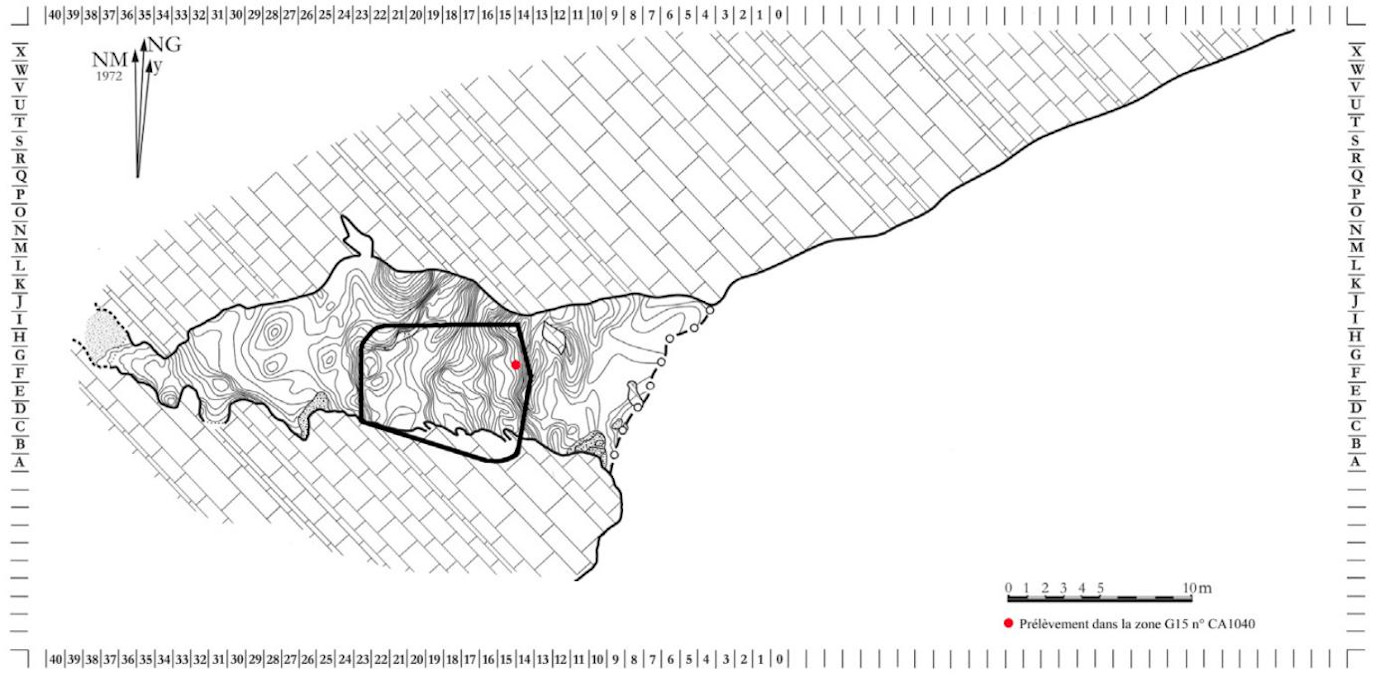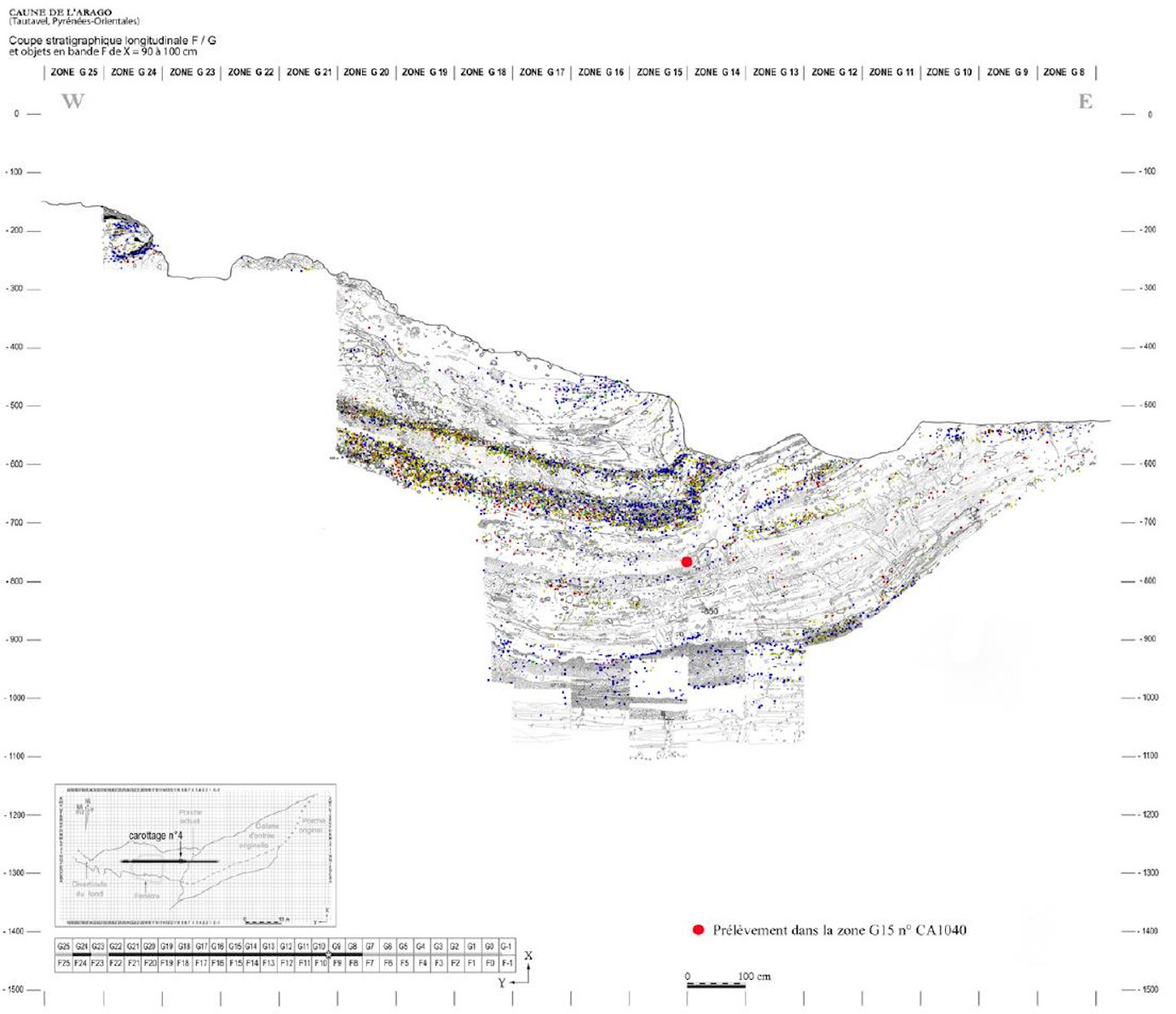A recent article ``Search for early traces of fire in the Caune de l’Arago at Tautavel (Eastern Pyrenees, France) combining magnetic susceptibility measurements, microscopic observation and Raman analysis'' has been published in Comptes Rendus Géoscience in Volume 353, 2021, pages 247-264 [Deldicque et al. 2021]. It reports the presence of traces of fire, in the filling of the Caune de l’Arago, dated to an ancient period of the middle Pleistocene.
However, it seems obvious that in the Caune de l’Arago before 400,000 years BP the European Homo erectus had not yet domesticated the fire and that they did not know how to light it at will. Indeed, on the Acheulean occupation levels of this site, older than 400,000 years BP, among more than 100,000 bones and fragments of very small bones uncovered, no trace of fire was observed. No charcoal, no trace of ashes, no stone splintered by fire have been spotted ([de Lumley et al. 2020]).
On the other hand, in the more recent levels, whose age is between 400,000 and over 100,000, burnt bones, charcoal, ashes and stones shattered by fire are present (large archaeostratigraphic units C, B and A of the upper stratigraphic complex and RFO of summit complex).

Current plan of the Caune de l’Arago and location of the open window in the ceiling of the cave (cf. [de Lumley, 2014, Figure 194, p. 358] ). The charcoal field, dated from the beginning of the 13th century to the end of the 17th century, extended from band 17 to band 14, on a horizontal truncation of the Quaternary filling. Its deposits, about 20 cm thick, were rich in charcoal and ash.
The same is true of other sites whose age is more recent than 400,000 years BP, such as Terra Amata site dated between 400,000 and 380,000 years BP ([de Lumley, 2009, 2011; de Lumley et al. 2011; de Lumley 2013, 2015b, 2015c, 2016; Valensi and de Lumley, 2016]), the Lazaret cave dated between 190,000 and 120,000 years BP ([de Lumley et al. 2018, 2020; de Lumley, 2020, 2018 ]), and the Hortus cave dated between 60,000 and 40,000 years BP ([de Lumley 1972]). In all these sites, burned bones, often very small and even tiny, are numerous, and charcoal, ashes, and stones shattered by fire are relatively abundant on all these occupation sites.
At the Caune de l’Arago, in the deposits of the upper and summit stratigraphic complexes, dated between 400,000 years BP at the base and 100,000 years BP at the summit, the presence of fire domesticated by man is demonstrated by the abundance of burned bones and the presence of charcoal, ashes when they have not been decarbonized, and stones shattered by the fire. How to explain the presence of wood microcharcoal of approximately 1 mm in a sedimentological sample taken in zone G15, at the level of stratigraphic complex I of the Middle Stratigraphic Complex dated to approximately 580,000 years BP?
In this sector of the Arago Cave, in vertical alignment with the south limit of an open window in the ceiling of the cave (Figure 1), numerous cracks of more than three meters in height in the sediments have been observed (Figure 1), related to the translation from top to bottom of the Quaternary filling. On the other hand, in a charcoal pit on the surface of the recent truncation of the Quaternary filling that extends to band 15, ash and charcoal dated by 14C between the beginning of the 13th and the end of the 17th centuries have accumulated to a thickness of more than 20 cm.

Projection on a vertical section of an archeological material according to the longitudinal stratigraphic section at the limit between F/G bands (cf. [de Lumley 2015a, Figure 196, p. 325]). A major flexure in the Middle Pleistocene fill is located at the limit between 14/15 bands, plumb with the southern wall of the open window in the ceiling of the cave, due to a vertical translation of the deposits from top to bottom, accompanied by numerous fissures. The deposits of the charcoal house, dated from the beginning of the 13th to the end of the 17th century, extended over a horizontal truncation of the filling, dated to the end of the Upper Pleistocene, from band 7 to band 12. Clandestine excavations by amateurs affected the Quaternary deposits of the large archeostratigraphic units G and L. Masquer
Projection on a vertical section of an archeological material according to the longitudinal stratigraphic section at the limit between F/G bands (cf. [de Lumley 2015a, Figure 196, p. 325]). A major flexure in the Middle Pleistocene fill is located at the limit ... Lire la suite
At the Caune de l’Arago, in the deposits of the upper and summit stratigraphic complexes, dated between 400,000 years BP at the base and 100,000 years BP at the summit, the presence of fire domesticated by man is demonstrated by the abundance of burned bones and the presence of charcoal, ashes when they have not been decarbonized, and stones shattered by the fire. How to explain the presence of wood microcharcoal of approximately 1 mm in a sedimentological sample taken in zone G15, at the level of stratigraphic complex I of the Middle Stratigraphic Complex dated to approximately 580,000 years BP?
In this sector of the Arago Cave, in vertical alignment with the south limit of an open window in the ceiling of the cave (Figure 1), numerous cracks of more than three meters in height in the sediments have been observed (Figure 2), related to the translation from top to bottom of the Quaternary filling. On the other hand, in a charcoal pit on the surface of the recent truncation of the Quaternary filling that extends to band 15, ash and charcoal dated by 14C between the beginning of the 13th and the end of the 17th centuries have accumulated to a thickness of more than 20 cm.
It is therefore likely that tiny charcoals have infiltrated the cracks in the fill of stratigraphic unit I over time.
Another explanation, mentioned by Christian Perrenoud in the article of which he is a co-author, would be that these wood microcharcoals were brought by the wind with the eolian sands that constitute the filling. They could have originated from natural fires in the surrounding forests.
Taking into account all the observations made at the site of the Caune de l’Arago during the excavations, it seems obvious that between 700,000 and 400,000 years BP, the hunting peoples who occupied the Caune de l’Arago did not use fire ([de Lumley, 2006; de Lumley et al. 2014; de Lumley, 2015c, 2016, 2006, 2017]).
Knowledge of the behavior and lifestyle of prehistoric man can only be obtained by taking into account all the results of multidisciplinary research carried out on the site during the excavations and subsequently in the laboratory.



 CC-BY 4.0
CC-BY 4.0